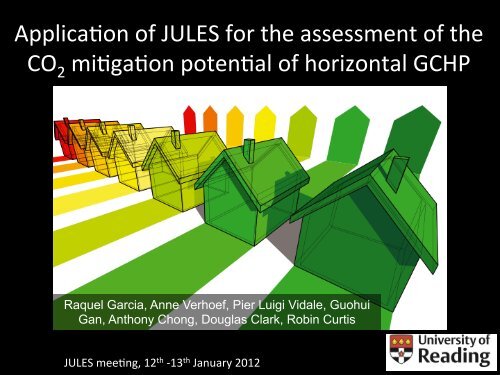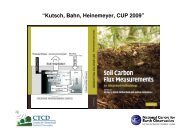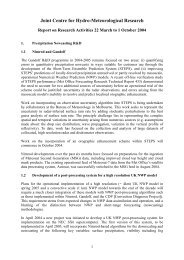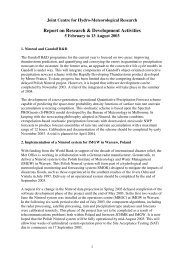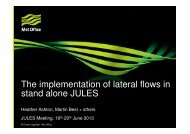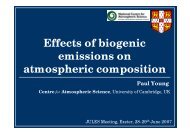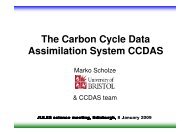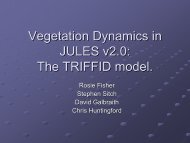T - JULES
T - JULES
T - JULES
Create successful ePaper yourself
Turn your PDF publications into a flip-book with our unique Google optimized e-Paper software.
Applica'on of <strong>JULES</strong> for the assessment of the <br />
CO 2 mi'ga'on poten'al of horizontal GCHP <br />
Raquel Garcia, Anne Verhoef, Pier Luigi Vidale, Guohui<br />
Gan, Anthony Chong, Douglas Clark, Robin Curtis<br />
<strong>JULES</strong> mee'ng, 12 th -‐13 th January 2012
Outline<br />
• Renewable heating in the UK<br />
• What is a Horizontal Ground Coupled Heat Pump (GCHP)?<br />
• GROMIT project tools<br />
• <strong>JULES</strong> Land Surface model <strong>JULES</strong>-‐HP <br />
• Heat extraction model<br />
• Field experiments – Drayton St Leonard<br />
• <strong>JULES</strong>-HP (1D) – Sensitivity runs<br />
• CO 2 Mitigation Potential<br />
• CHESS <strong>JULES</strong>-HP – UK distributed runs<br />
• Conclusions/Recommendations<br />
Aim: To investigate and optimise the CO 2 mitigation<br />
potential of horizontal GCHPs under current and future<br />
UK environmental conditions
Impacts of climate change<br />
• Imbalance between population numbers and vital sustaining<br />
resources:<br />
• Food supply, crops<br />
• Water availability<br />
• Ecosystems
Impacts of climate change<br />
• Imbalance between population numbers and vital sustaining<br />
resources:<br />
• Food supply, crops<br />
• Water availability<br />
• Ecosystems<br />
• ENERGY SUPPLY<br />
• Increase opposition/distrust to Nuclear Technology development<br />
• Interest turns now to the development of Renewable source of energy
Renewable heating in the UK<br />
By 2020, UK needs to generate 15% of its consumed energy from renewables, up<br />
from 6.7% in 2009, to meet our contribution to the EU renewable energy target<br />
Heating and cooling systems of buildings account for 30%-50% of the global<br />
energy consumption [Kharseh et al., 2010]<br />
Low-carbon technologies such as horizontal GCHPs can contribute to reduce<br />
UK’s energy bills and reduce the CO 2 emissions<br />
Semi-detached and detached dwellings account for approximately 40% of the total<br />
housing stocks in the UK [Singh, 2010]<br />
Increased interest of Government and Industry in the UK, but also at the European<br />
Community level and International agencies to develop further this technology:<br />
- Financial support schemes - Renewable Heat Incentive (RHI)<br />
- Independent advice for customers - Energy Saving Trust (EST)
What is a horizontal Ground Source<br />
Heat Pump (GCHP)?<br />
COP: Coefficient of Performance <br />
heat _ output<br />
COP =<br />
electricity _input<br />
UpliF temperature = 35 o C – 10 o C = 25 o C <br />
60 o C – 10 o C = 50 o C <br />
! = v 1(T 1<br />
!T 2<br />
)<br />
v 2<br />
(T 3<br />
!T 4<br />
)<br />
D <br />
S
Range of GCHP systems<br />
Source: Energy Saving Trust, Heat Pump Technical Monitoring Specifica'on, 2008 <br />
COP = f(A, B,C) <br />
A <strong>JULES</strong>-‐HP <br />
B C <br />
Ground<br />
Air<br />
Heat source<br />
Coil<br />
(Five variations)<br />
Single pipe<br />
Borehole<br />
External<br />
Conditioned<br />
Equipment<br />
type<br />
Heat<br />
pump<br />
(Approximately<br />
ten variations)<br />
Water heating<br />
Space heating<br />
Heat sink<br />
To air<br />
(Seven combinations)<br />
Low temperature<br />
(for example underfloor)<br />
High temperature<br />
(for example radiators)
GROMIT project tools<br />
GCHP model<br />
Land surface model<br />
UK Driving data, e.g.<br />
Air Temperature (K)<br />
1 January 2003<br />
Model <br />
development <br />
Impact <br />
studies <br />
Field experiments<br />
UK Soil texture <br />
data, to calculate <br />
soil physical <br />
proper'es
This methodology could help to:<br />
• Expand the use of this technology/<br />
op'mize the design and installa'on <br />
• Predict the COP and thus the CO 2 <br />
mi'ga'on poten'al for different <br />
combina'ons of soil type/GCHP system <br />
• Make recommenda'ons to relevant <br />
government bodies concerning the <br />
op'mal configura'on of future <br />
installa'ons of GCHPs at UK domes'c, <br />
ins'tu'onal, commercial and agricultural <br />
developments <br />
Sensible heat<br />
flux<br />
Soil heat flux<br />
Radiation<br />
Horizontal heat exchanger<br />
Heat extraction / Cooling<br />
Evaporation
<strong>JULES</strong>-heat extraction model (<strong>JULES</strong>-HP)<br />
Dynamic interac'on between the soil environment and the heat pump <br />
"T<br />
C A<br />
!z i<br />
i<br />
"t = " #<br />
"z ! i<br />
$<br />
%<br />
"T i<br />
"z<br />
&<br />
'<br />
( ) c "T<br />
wW l,i<br />
!z i<br />
i<br />
"z<br />
Heat transfer in <strong>JULES</strong> <br />
C h,i<br />
!! i<br />
!t<br />
= ! "<br />
!z k !! i<br />
i<br />
!z + K %<br />
i<br />
#<br />
$<br />
&<br />
' ( E i<br />
Flow of water in <strong>JULES</strong> <br />
q = 2!" i<br />
L T pipe !T i<br />
( )<br />
ln d po2<br />
d po<br />
= AU pipe<br />
T f<br />
!T pipe<br />
Heat flux from a layer of soil outside the pipe equals the heat <br />
transfer from outer surface to inner surface of pipe
Preliminary studies, Drayton St Leonard, near Oxford<br />
!T " q<br />
Average soil temp differences between the slinky and the<br />
reference profile for Drayton St Leonard
Preliminary studies, Drayton St Leonard, near Oxford<br />
!T " q<br />
Average soil temp differences between the slinky and the<br />
reference profile for Drayton St Leonard
GROMIT rationale<br />
A B C <br />
Model simulation<br />
Source: Energy Saving Trust, - Verification Heat Pump (1D Technical simulations) Monitoring Specifica'on, 2008 <br />
- Sensitivity runs
<strong>JULES</strong>-HP 1D sensitivity runs<br />
1. Installation depth<br />
(1.0m, 1.5m and 2.0m)<br />
2. Pipe configuration and loop<br />
spacing<br />
3. Fluid temperature<br />
T f = 273 - 275 K<br />
4. Soil texture<br />
Courtesy of D. Clark, Soil temperature <br />
(average over 3m), December
<strong>JULES</strong>-HP 1D sensitivity runs<br />
Rothamsted site <br />
Rothamsted
<strong>JULES</strong>-HP 1D sensitivity runs<br />
Moor House <br />
Unfrozen soil moisture content <br />
Frozen soil moisture content
<strong>JULES</strong>-HP 1D sensitivity runs<br />
Moor House <br />
Slinky coil diameters (D) = 1m <br />
Spacing between coils (S) =1.5 m
<strong>JULES</strong>-HP CHESS runs<br />
A B C <br />
Model simulation<br />
- Climate change impact<br />
- Climate change scenarios (UKCIP)<br />
Source: Energy Saving Trust, Heat Pump Technical Monitoring Specifica'on, 2008 <br />
- COP under future environmental conditions
CO 2 savings – Mitigation potential<br />
126<br />
P. Blum et al. / Renewable Energy 35 (2010) 122–127<br />
Geothermal CO 2 emission (GCE, g/year) <br />
!"#<br />
!<br />
!"#$<br />
! !!" !" ! !!"#$<br />
!!"#$<br />
!"#$ ! !" !"# !<br />
!"! !<br />
Conven'onal CO 2 emission (CCE, g/year) <br />
!!"<br />
!<br />
!"#$<br />
! !" !" ! !!"#$<br />
!!"#$<br />
!"#$ !! !" !"# !<br />
!"! !<br />
!"<br />
CO 2 savings (CS, g/year) <br />
!<br />
!"#$ ! !"# !<br />
!"#$ ! !!" !<br />
!"!" !<br />
i.e. A heat pump of ~10KW th installed in <br />
Reading is able to produce approximately <br />
21000KWh heat annually >> <br />
CO 2 savings ~ 2500 Kg/year <br />
35% or 72% CO 2 Savings <br />
depending on the electricity mix used <br />
Blum et al., 2010
Conclusions – Recommendations<br />
- Installation depths at 1.0m give us higher heat extractions rates,<br />
however it would be preferable to install the pipes slightly deeper to<br />
avoid the influence by variable meteorological conditions<br />
- A value of 1.5m for the spacing between coils is recommended to<br />
avoid disturbances between the neighbours coils<br />
- For larger values for the spacing between the coils (S=2m, S=3), a<br />
slightly smaller slinky coil diameter would be better (0.8m)<br />
- The fluid temperature of the pipe will have a direct effect on the heat<br />
extraction rates of the system<br />
- The coefficient of performance of a heat pump will not remain<br />
constant and will depend on the operating conditions and outdoor<br />
temperatures
THANKS!


